Food Safety Framework for Management in the Hospitality Sector
VerifiedAdded on 2023/04/21
|10
|1962
|90
AI Summary
This article discusses the importance of food safety in the hospitality sector and provides insights into implementing a food safety management framework. It explores key regulations and laws in Australia and offers recommendations for ensuring food safety.
Contribute Materials
Your contribution can guide someone’s learning journey. Share your
documents today.
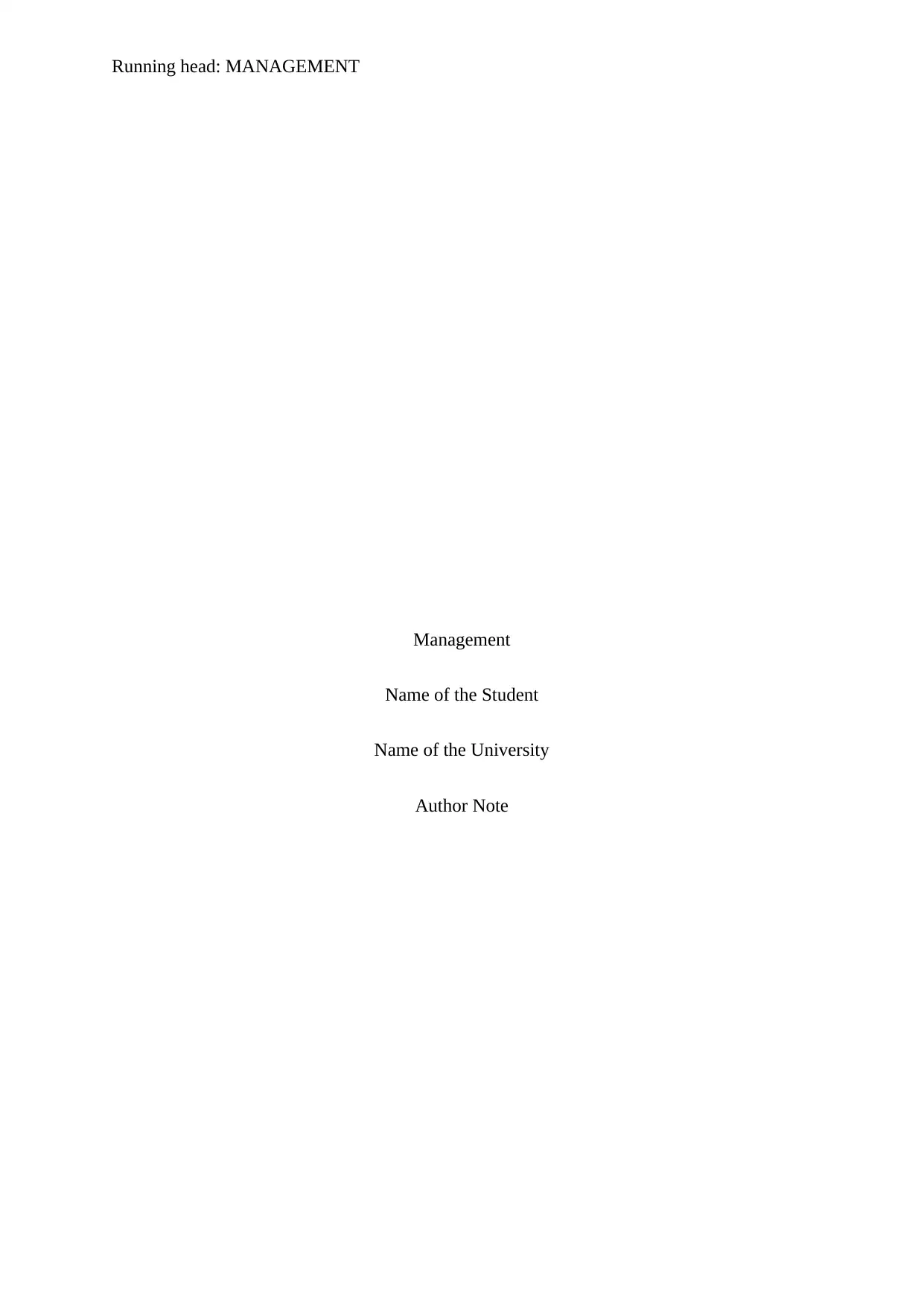
Running head: MANAGEMENT
Management
Name of the Student
Name of the University
Author Note
Management
Name of the Student
Name of the University
Author Note
Secure Best Marks with AI Grader
Need help grading? Try our AI Grader for instant feedback on your assignments.
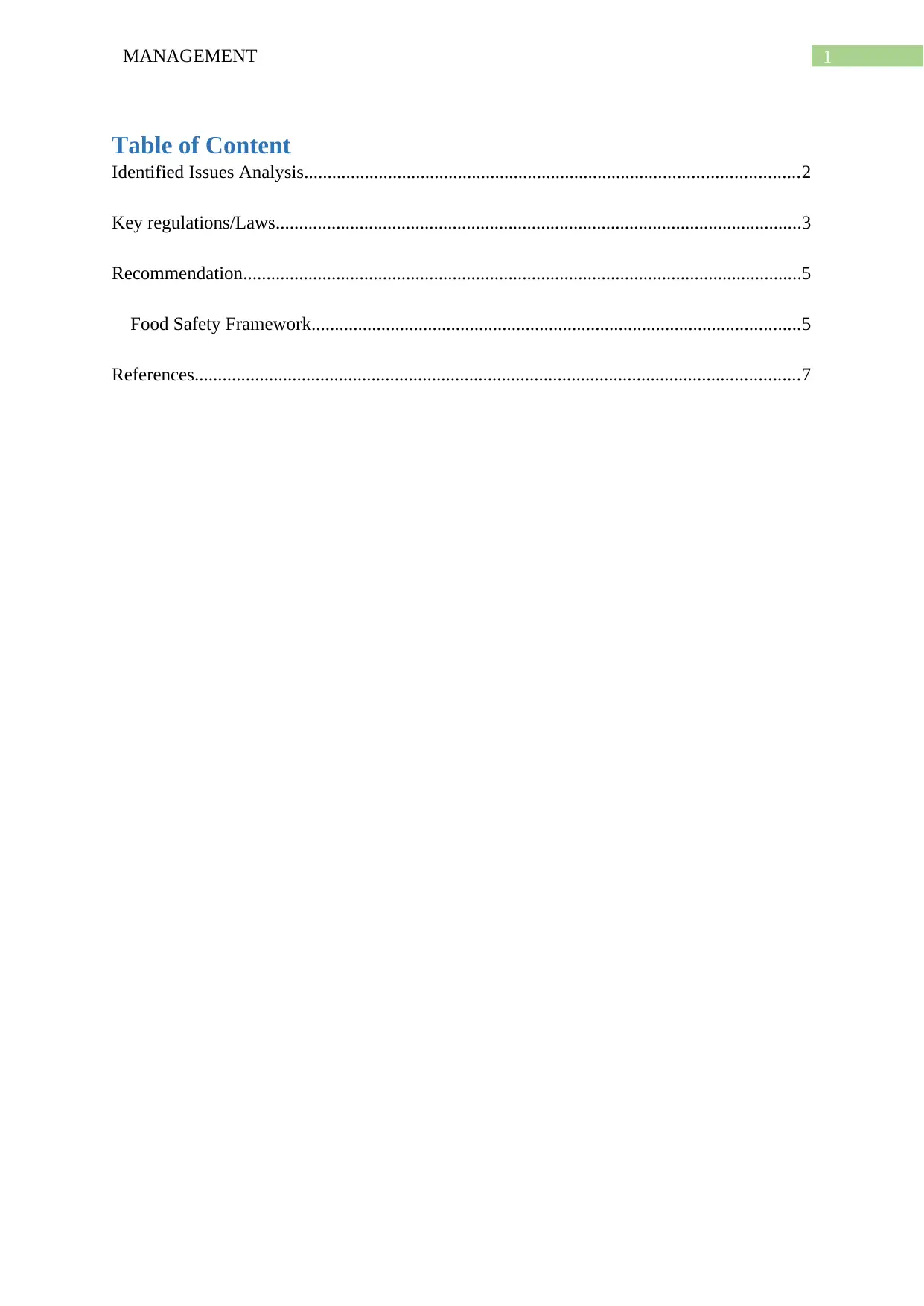
1MANAGEMENT
Table of Content
Identified Issues Analysis..........................................................................................................2
Key regulations/Laws.................................................................................................................3
Recommendation........................................................................................................................5
Food Safety Framework.........................................................................................................5
References..................................................................................................................................7
Table of Content
Identified Issues Analysis..........................................................................................................2
Key regulations/Laws.................................................................................................................3
Recommendation........................................................................................................................5
Food Safety Framework.........................................................................................................5
References..................................................................................................................................7
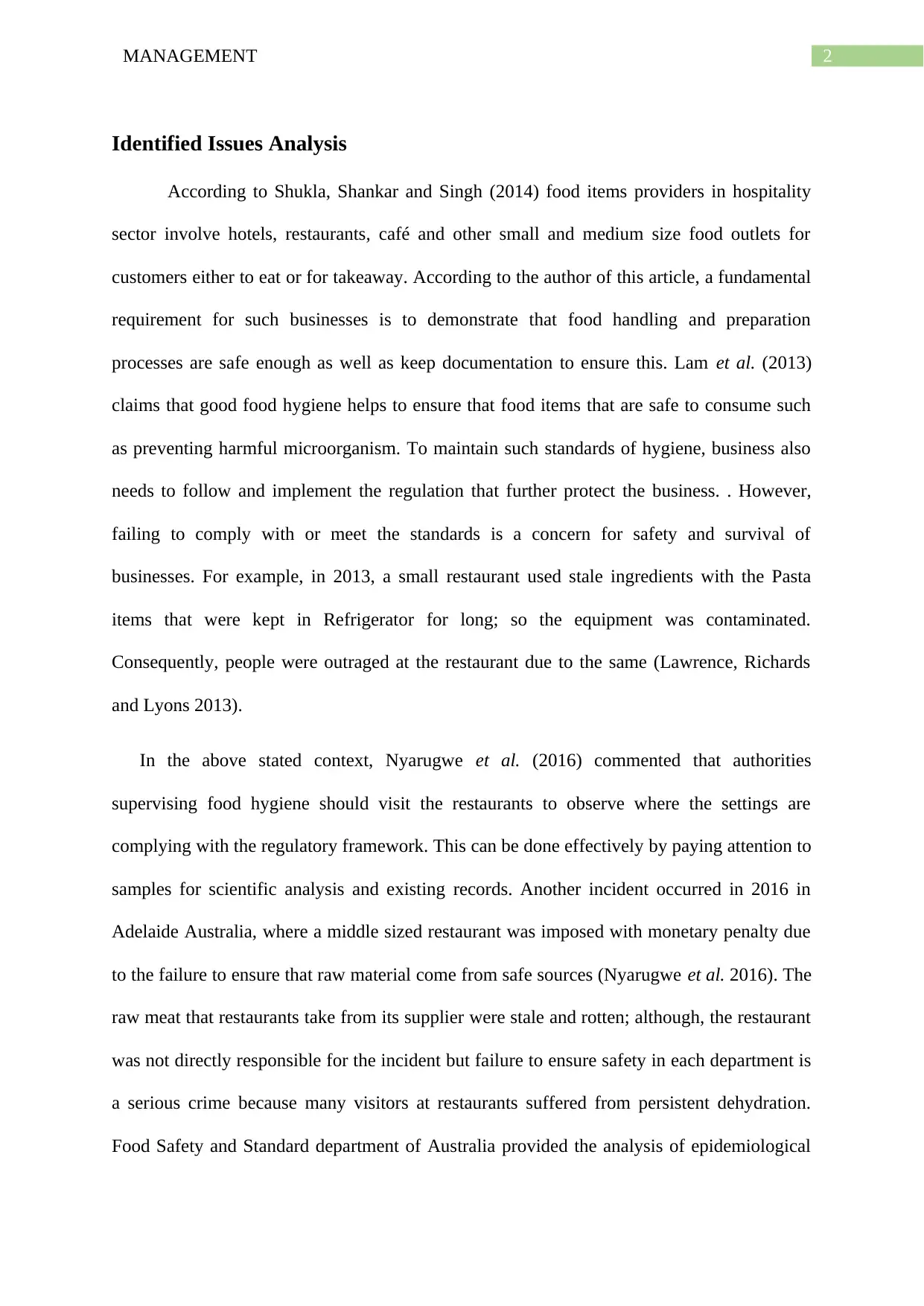
2MANAGEMENT
Identified Issues Analysis
According to Shukla, Shankar and Singh (2014) food items providers in hospitality
sector involve hotels, restaurants, café and other small and medium size food outlets for
customers either to eat or for takeaway. According to the author of this article, a fundamental
requirement for such businesses is to demonstrate that food handling and preparation
processes are safe enough as well as keep documentation to ensure this. Lam et al. (2013)
claims that good food hygiene helps to ensure that food items that are safe to consume such
as preventing harmful microorganism. To maintain such standards of hygiene, business also
needs to follow and implement the regulation that further protect the business. . However,
failing to comply with or meet the standards is a concern for safety and survival of
businesses. For example, in 2013, a small restaurant used stale ingredients with the Pasta
items that were kept in Refrigerator for long; so the equipment was contaminated.
Consequently, people were outraged at the restaurant due to the same (Lawrence, Richards
and Lyons 2013).
In the above stated context, Nyarugwe et al. (2016) commented that authorities
supervising food hygiene should visit the restaurants to observe where the settings are
complying with the regulatory framework. This can be done effectively by paying attention to
samples for scientific analysis and existing records. Another incident occurred in 2016 in
Adelaide Australia, where a middle sized restaurant was imposed with monetary penalty due
to the failure to ensure that raw material come from safe sources (Nyarugwe et al. 2016). The
raw meat that restaurants take from its supplier were stale and rotten; although, the restaurant
was not directly responsible for the incident but failure to ensure safety in each department is
a serious crime because many visitors at restaurants suffered from persistent dehydration.
Food Safety and Standard department of Australia provided the analysis of epidemiological
Identified Issues Analysis
According to Shukla, Shankar and Singh (2014) food items providers in hospitality
sector involve hotels, restaurants, café and other small and medium size food outlets for
customers either to eat or for takeaway. According to the author of this article, a fundamental
requirement for such businesses is to demonstrate that food handling and preparation
processes are safe enough as well as keep documentation to ensure this. Lam et al. (2013)
claims that good food hygiene helps to ensure that food items that are safe to consume such
as preventing harmful microorganism. To maintain such standards of hygiene, business also
needs to follow and implement the regulation that further protect the business. . However,
failing to comply with or meet the standards is a concern for safety and survival of
businesses. For example, in 2013, a small restaurant used stale ingredients with the Pasta
items that were kept in Refrigerator for long; so the equipment was contaminated.
Consequently, people were outraged at the restaurant due to the same (Lawrence, Richards
and Lyons 2013).
In the above stated context, Nyarugwe et al. (2016) commented that authorities
supervising food hygiene should visit the restaurants to observe where the settings are
complying with the regulatory framework. This can be done effectively by paying attention to
samples for scientific analysis and existing records. Another incident occurred in 2016 in
Adelaide Australia, where a middle sized restaurant was imposed with monetary penalty due
to the failure to ensure that raw material come from safe sources (Nyarugwe et al. 2016). The
raw meat that restaurants take from its supplier were stale and rotten; although, the restaurant
was not directly responsible for the incident but failure to ensure safety in each department is
a serious crime because many visitors at restaurants suffered from persistent dehydration.
Food Safety and Standard department of Australia provided the analysis of epidemiological
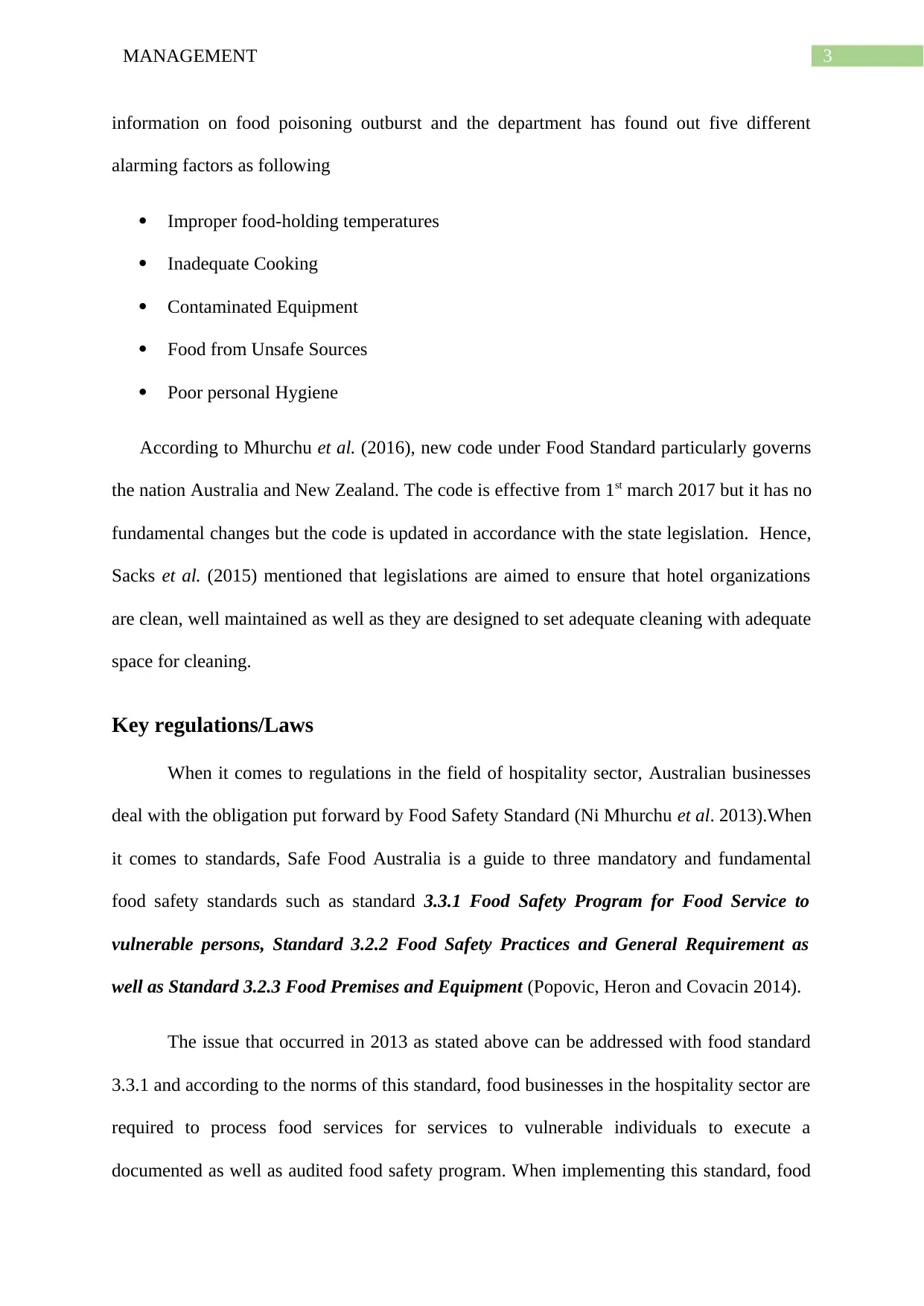
3MANAGEMENT
information on food poisoning outburst and the department has found out five different
alarming factors as following
Improper food-holding temperatures
Inadequate Cooking
Contaminated Equipment
Food from Unsafe Sources
Poor personal Hygiene
According to Mhurchu et al. (2016), new code under Food Standard particularly governs
the nation Australia and New Zealand. The code is effective from 1st march 2017 but it has no
fundamental changes but the code is updated in accordance with the state legislation. Hence,
Sacks et al. (2015) mentioned that legislations are aimed to ensure that hotel organizations
are clean, well maintained as well as they are designed to set adequate cleaning with adequate
space for cleaning.
Key regulations/Laws
When it comes to regulations in the field of hospitality sector, Australian businesses
deal with the obligation put forward by Food Safety Standard (Ni Mhurchu et al. 2013).When
it comes to standards, Safe Food Australia is a guide to three mandatory and fundamental
food safety standards such as standard 3.3.1 Food Safety Program for Food Service to
vulnerable persons, Standard 3.2.2 Food Safety Practices and General Requirement as
well as Standard 3.2.3 Food Premises and Equipment (Popovic, Heron and Covacin 2014).
The issue that occurred in 2013 as stated above can be addressed with food standard
3.3.1 and according to the norms of this standard, food businesses in the hospitality sector are
required to process food services for services to vulnerable individuals to execute a
documented as well as audited food safety program. When implementing this standard, food
information on food poisoning outburst and the department has found out five different
alarming factors as following
Improper food-holding temperatures
Inadequate Cooking
Contaminated Equipment
Food from Unsafe Sources
Poor personal Hygiene
According to Mhurchu et al. (2016), new code under Food Standard particularly governs
the nation Australia and New Zealand. The code is effective from 1st march 2017 but it has no
fundamental changes but the code is updated in accordance with the state legislation. Hence,
Sacks et al. (2015) mentioned that legislations are aimed to ensure that hotel organizations
are clean, well maintained as well as they are designed to set adequate cleaning with adequate
space for cleaning.
Key regulations/Laws
When it comes to regulations in the field of hospitality sector, Australian businesses
deal with the obligation put forward by Food Safety Standard (Ni Mhurchu et al. 2013).When
it comes to standards, Safe Food Australia is a guide to three mandatory and fundamental
food safety standards such as standard 3.3.1 Food Safety Program for Food Service to
vulnerable persons, Standard 3.2.2 Food Safety Practices and General Requirement as
well as Standard 3.2.3 Food Premises and Equipment (Popovic, Heron and Covacin 2014).
The issue that occurred in 2013 as stated above can be addressed with food standard
3.3.1 and according to the norms of this standard, food businesses in the hospitality sector are
required to process food services for services to vulnerable individuals to execute a
documented as well as audited food safety program. When implementing this standard, food
Secure Best Marks with AI Grader
Need help grading? Try our AI Grader for instant feedback on your assignments.
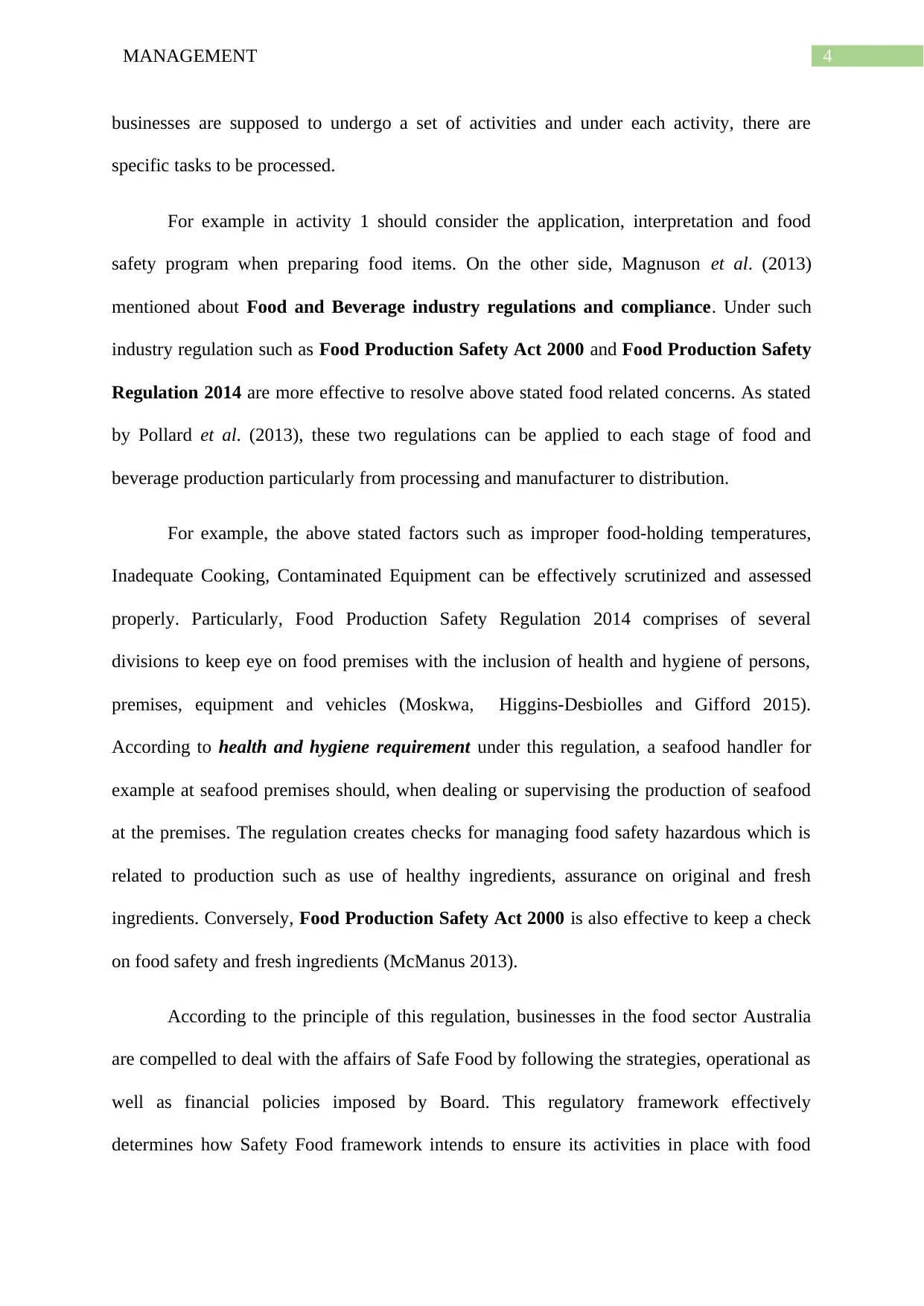
4MANAGEMENT
businesses are supposed to undergo a set of activities and under each activity, there are
specific tasks to be processed.
For example in activity 1 should consider the application, interpretation and food
safety program when preparing food items. On the other side, Magnuson et al. (2013)
mentioned about Food and Beverage industry regulations and compliance. Under such
industry regulation such as Food Production Safety Act 2000 and Food Production Safety
Regulation 2014 are more effective to resolve above stated food related concerns. As stated
by Pollard et al. (2013), these two regulations can be applied to each stage of food and
beverage production particularly from processing and manufacturer to distribution.
For example, the above stated factors such as improper food-holding temperatures,
Inadequate Cooking, Contaminated Equipment can be effectively scrutinized and assessed
properly. Particularly, Food Production Safety Regulation 2014 comprises of several
divisions to keep eye on food premises with the inclusion of health and hygiene of persons,
premises, equipment and vehicles (Moskwa, Higgins-Desbiolles and Gifford 2015).
According to health and hygiene requirement under this regulation, a seafood handler for
example at seafood premises should, when dealing or supervising the production of seafood
at the premises. The regulation creates checks for managing food safety hazardous which is
related to production such as use of healthy ingredients, assurance on original and fresh
ingredients. Conversely, Food Production Safety Act 2000 is also effective to keep a check
on food safety and fresh ingredients (McManus 2013).
According to the principle of this regulation, businesses in the food sector Australia
are compelled to deal with the affairs of Safe Food by following the strategies, operational as
well as financial policies imposed by Board. This regulatory framework effectively
determines how Safety Food framework intends to ensure its activities in place with food
businesses are supposed to undergo a set of activities and under each activity, there are
specific tasks to be processed.
For example in activity 1 should consider the application, interpretation and food
safety program when preparing food items. On the other side, Magnuson et al. (2013)
mentioned about Food and Beverage industry regulations and compliance. Under such
industry regulation such as Food Production Safety Act 2000 and Food Production Safety
Regulation 2014 are more effective to resolve above stated food related concerns. As stated
by Pollard et al. (2013), these two regulations can be applied to each stage of food and
beverage production particularly from processing and manufacturer to distribution.
For example, the above stated factors such as improper food-holding temperatures,
Inadequate Cooking, Contaminated Equipment can be effectively scrutinized and assessed
properly. Particularly, Food Production Safety Regulation 2014 comprises of several
divisions to keep eye on food premises with the inclusion of health and hygiene of persons,
premises, equipment and vehicles (Moskwa, Higgins-Desbiolles and Gifford 2015).
According to health and hygiene requirement under this regulation, a seafood handler for
example at seafood premises should, when dealing or supervising the production of seafood
at the premises. The regulation creates checks for managing food safety hazardous which is
related to production such as use of healthy ingredients, assurance on original and fresh
ingredients. Conversely, Food Production Safety Act 2000 is also effective to keep a check
on food safety and fresh ingredients (McManus 2013).
According to the principle of this regulation, businesses in the food sector Australia
are compelled to deal with the affairs of Safe Food by following the strategies, operational as
well as financial policies imposed by Board. This regulatory framework effectively
determines how Safety Food framework intends to ensure its activities in place with food
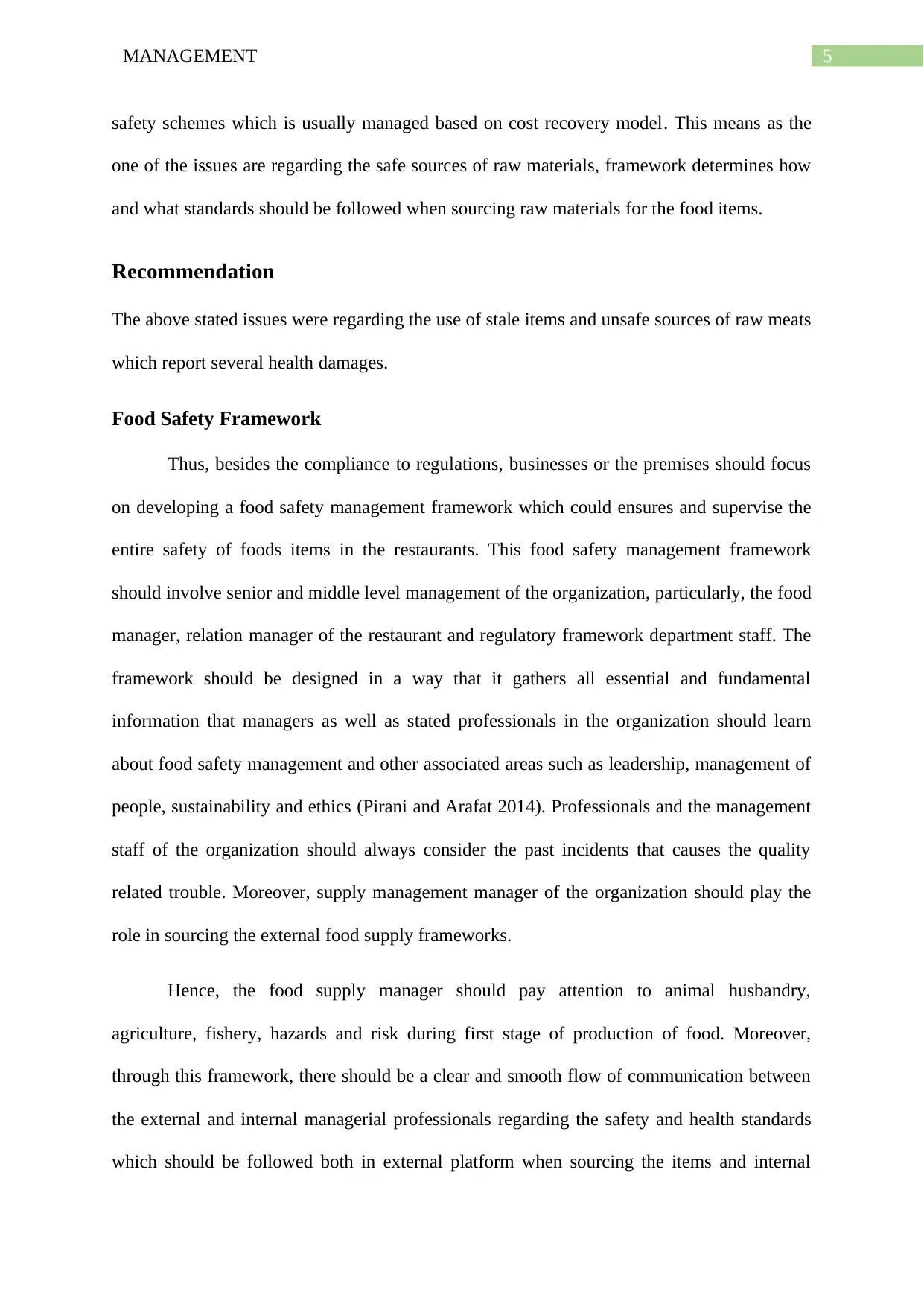
5MANAGEMENT
safety schemes which is usually managed based on cost recovery model. This means as the
one of the issues are regarding the safe sources of raw materials, framework determines how
and what standards should be followed when sourcing raw materials for the food items.
Recommendation
The above stated issues were regarding the use of stale items and unsafe sources of raw meats
which report several health damages.
Food Safety Framework
Thus, besides the compliance to regulations, businesses or the premises should focus
on developing a food safety management framework which could ensures and supervise the
entire safety of foods items in the restaurants. This food safety management framework
should involve senior and middle level management of the organization, particularly, the food
manager, relation manager of the restaurant and regulatory framework department staff. The
framework should be designed in a way that it gathers all essential and fundamental
information that managers as well as stated professionals in the organization should learn
about food safety management and other associated areas such as leadership, management of
people, sustainability and ethics (Pirani and Arafat 2014). Professionals and the management
staff of the organization should always consider the past incidents that causes the quality
related trouble. Moreover, supply management manager of the organization should play the
role in sourcing the external food supply frameworks.
Hence, the food supply manager should pay attention to animal husbandry,
agriculture, fishery, hazards and risk during first stage of production of food. Moreover,
through this framework, there should be a clear and smooth flow of communication between
the external and internal managerial professionals regarding the safety and health standards
which should be followed both in external platform when sourcing the items and internal
safety schemes which is usually managed based on cost recovery model. This means as the
one of the issues are regarding the safe sources of raw materials, framework determines how
and what standards should be followed when sourcing raw materials for the food items.
Recommendation
The above stated issues were regarding the use of stale items and unsafe sources of raw meats
which report several health damages.
Food Safety Framework
Thus, besides the compliance to regulations, businesses or the premises should focus
on developing a food safety management framework which could ensures and supervise the
entire safety of foods items in the restaurants. This food safety management framework
should involve senior and middle level management of the organization, particularly, the food
manager, relation manager of the restaurant and regulatory framework department staff. The
framework should be designed in a way that it gathers all essential and fundamental
information that managers as well as stated professionals in the organization should learn
about food safety management and other associated areas such as leadership, management of
people, sustainability and ethics (Pirani and Arafat 2014). Professionals and the management
staff of the organization should always consider the past incidents that causes the quality
related trouble. Moreover, supply management manager of the organization should play the
role in sourcing the external food supply frameworks.
Hence, the food supply manager should pay attention to animal husbandry,
agriculture, fishery, hazards and risk during first stage of production of food. Moreover,
through this framework, there should be a clear and smooth flow of communication between
the external and internal managerial professionals regarding the safety and health standards
which should be followed both in external platform when sourcing the items and internal
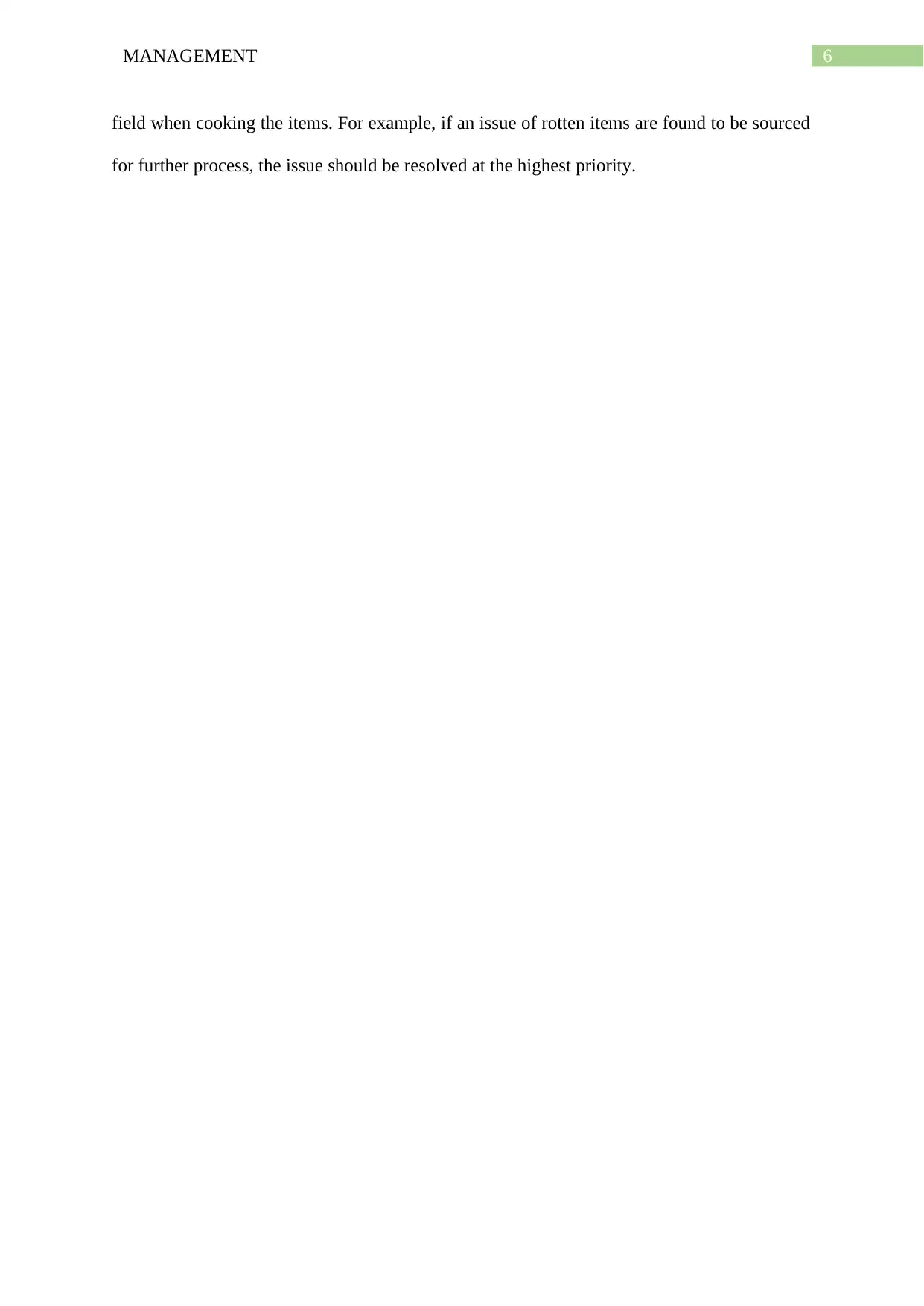
6MANAGEMENT
field when cooking the items. For example, if an issue of rotten items are found to be sourced
for further process, the issue should be resolved at the highest priority.
field when cooking the items. For example, if an issue of rotten items are found to be sourced
for further process, the issue should be resolved at the highest priority.
Paraphrase This Document
Need a fresh take? Get an instant paraphrase of this document with our AI Paraphraser
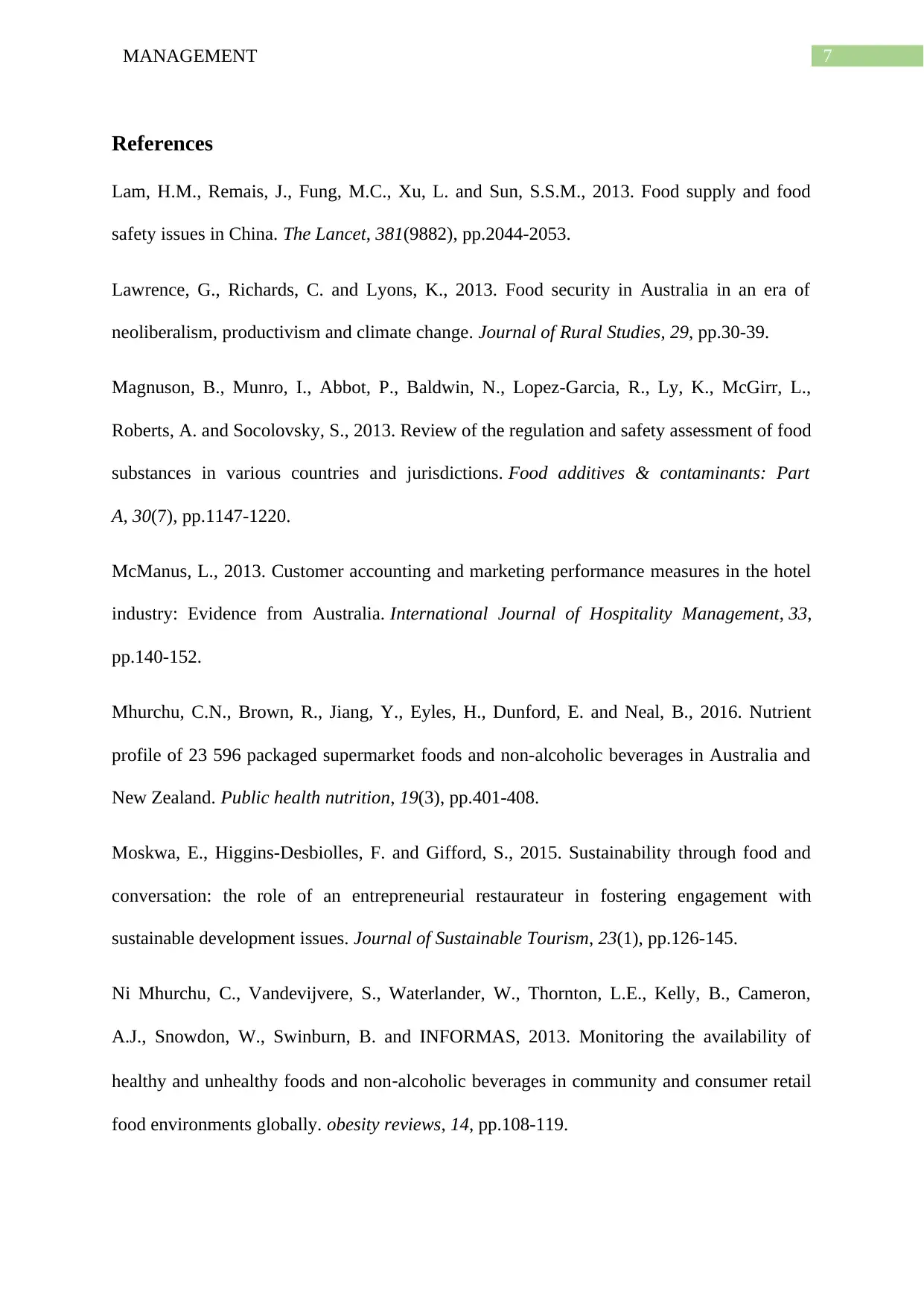
7MANAGEMENT
References
Lam, H.M., Remais, J., Fung, M.C., Xu, L. and Sun, S.S.M., 2013. Food supply and food
safety issues in China. The Lancet, 381(9882), pp.2044-2053.
Lawrence, G., Richards, C. and Lyons, K., 2013. Food security in Australia in an era of
neoliberalism, productivism and climate change. Journal of Rural Studies, 29, pp.30-39.
Magnuson, B., Munro, I., Abbot, P., Baldwin, N., Lopez-Garcia, R., Ly, K., McGirr, L.,
Roberts, A. and Socolovsky, S., 2013. Review of the regulation and safety assessment of food
substances in various countries and jurisdictions. Food additives & contaminants: Part
A, 30(7), pp.1147-1220.
McManus, L., 2013. Customer accounting and marketing performance measures in the hotel
industry: Evidence from Australia. International Journal of Hospitality Management, 33,
pp.140-152.
Mhurchu, C.N., Brown, R., Jiang, Y., Eyles, H., Dunford, E. and Neal, B., 2016. Nutrient
profile of 23 596 packaged supermarket foods and non-alcoholic beverages in Australia and
New Zealand. Public health nutrition, 19(3), pp.401-408.
Moskwa, E., Higgins-Desbiolles, F. and Gifford, S., 2015. Sustainability through food and
conversation: the role of an entrepreneurial restaurateur in fostering engagement with
sustainable development issues. Journal of Sustainable Tourism, 23(1), pp.126-145.
Ni Mhurchu, C., Vandevijvere, S., Waterlander, W., Thornton, L.E., Kelly, B., Cameron,
A.J., Snowdon, W., Swinburn, B. and INFORMAS, 2013. Monitoring the availability of
healthy and unhealthy foods and non‐alcoholic beverages in community and consumer retail
food environments globally. obesity reviews, 14, pp.108-119.
References
Lam, H.M., Remais, J., Fung, M.C., Xu, L. and Sun, S.S.M., 2013. Food supply and food
safety issues in China. The Lancet, 381(9882), pp.2044-2053.
Lawrence, G., Richards, C. and Lyons, K., 2013. Food security in Australia in an era of
neoliberalism, productivism and climate change. Journal of Rural Studies, 29, pp.30-39.
Magnuson, B., Munro, I., Abbot, P., Baldwin, N., Lopez-Garcia, R., Ly, K., McGirr, L.,
Roberts, A. and Socolovsky, S., 2013. Review of the regulation and safety assessment of food
substances in various countries and jurisdictions. Food additives & contaminants: Part
A, 30(7), pp.1147-1220.
McManus, L., 2013. Customer accounting and marketing performance measures in the hotel
industry: Evidence from Australia. International Journal of Hospitality Management, 33,
pp.140-152.
Mhurchu, C.N., Brown, R., Jiang, Y., Eyles, H., Dunford, E. and Neal, B., 2016. Nutrient
profile of 23 596 packaged supermarket foods and non-alcoholic beverages in Australia and
New Zealand. Public health nutrition, 19(3), pp.401-408.
Moskwa, E., Higgins-Desbiolles, F. and Gifford, S., 2015. Sustainability through food and
conversation: the role of an entrepreneurial restaurateur in fostering engagement with
sustainable development issues. Journal of Sustainable Tourism, 23(1), pp.126-145.
Ni Mhurchu, C., Vandevijvere, S., Waterlander, W., Thornton, L.E., Kelly, B., Cameron,
A.J., Snowdon, W., Swinburn, B. and INFORMAS, 2013. Monitoring the availability of
healthy and unhealthy foods and non‐alcoholic beverages in community and consumer retail
food environments globally. obesity reviews, 14, pp.108-119.
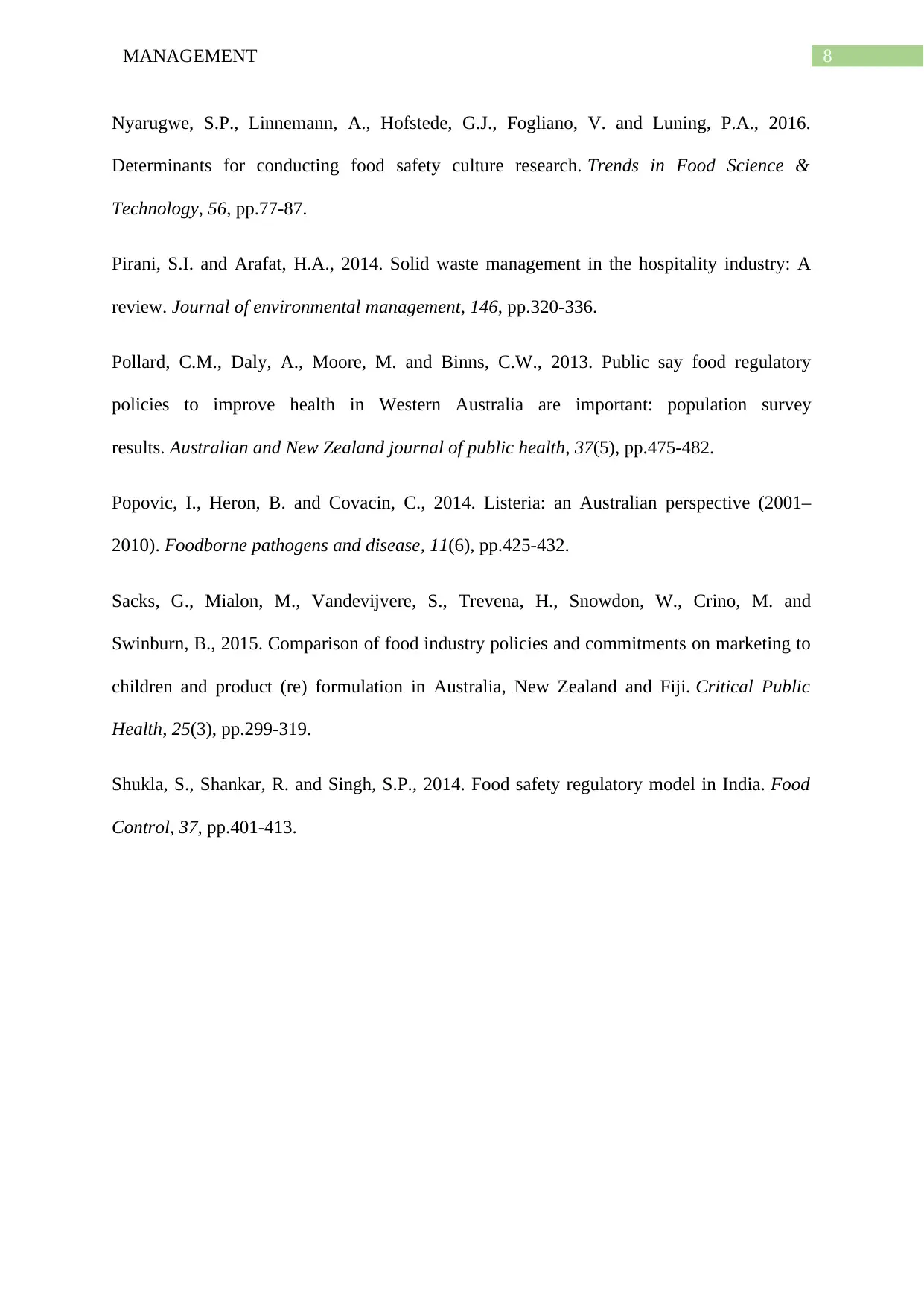
8MANAGEMENT
Nyarugwe, S.P., Linnemann, A., Hofstede, G.J., Fogliano, V. and Luning, P.A., 2016.
Determinants for conducting food safety culture research. Trends in Food Science &
Technology, 56, pp.77-87.
Pirani, S.I. and Arafat, H.A., 2014. Solid waste management in the hospitality industry: A
review. Journal of environmental management, 146, pp.320-336.
Pollard, C.M., Daly, A., Moore, M. and Binns, C.W., 2013. Public say food regulatory
policies to improve health in Western Australia are important: population survey
results. Australian and New Zealand journal of public health, 37(5), pp.475-482.
Popovic, I., Heron, B. and Covacin, C., 2014. Listeria: an Australian perspective (2001–
2010). Foodborne pathogens and disease, 11(6), pp.425-432.
Sacks, G., Mialon, M., Vandevijvere, S., Trevena, H., Snowdon, W., Crino, M. and
Swinburn, B., 2015. Comparison of food industry policies and commitments on marketing to
children and product (re) formulation in Australia, New Zealand and Fiji. Critical Public
Health, 25(3), pp.299-319.
Shukla, S., Shankar, R. and Singh, S.P., 2014. Food safety regulatory model in India. Food
Control, 37, pp.401-413.
Nyarugwe, S.P., Linnemann, A., Hofstede, G.J., Fogliano, V. and Luning, P.A., 2016.
Determinants for conducting food safety culture research. Trends in Food Science &
Technology, 56, pp.77-87.
Pirani, S.I. and Arafat, H.A., 2014. Solid waste management in the hospitality industry: A
review. Journal of environmental management, 146, pp.320-336.
Pollard, C.M., Daly, A., Moore, M. and Binns, C.W., 2013. Public say food regulatory
policies to improve health in Western Australia are important: population survey
results. Australian and New Zealand journal of public health, 37(5), pp.475-482.
Popovic, I., Heron, B. and Covacin, C., 2014. Listeria: an Australian perspective (2001–
2010). Foodborne pathogens and disease, 11(6), pp.425-432.
Sacks, G., Mialon, M., Vandevijvere, S., Trevena, H., Snowdon, W., Crino, M. and
Swinburn, B., 2015. Comparison of food industry policies and commitments on marketing to
children and product (re) formulation in Australia, New Zealand and Fiji. Critical Public
Health, 25(3), pp.299-319.
Shukla, S., Shankar, R. and Singh, S.P., 2014. Food safety regulatory model in India. Food
Control, 37, pp.401-413.
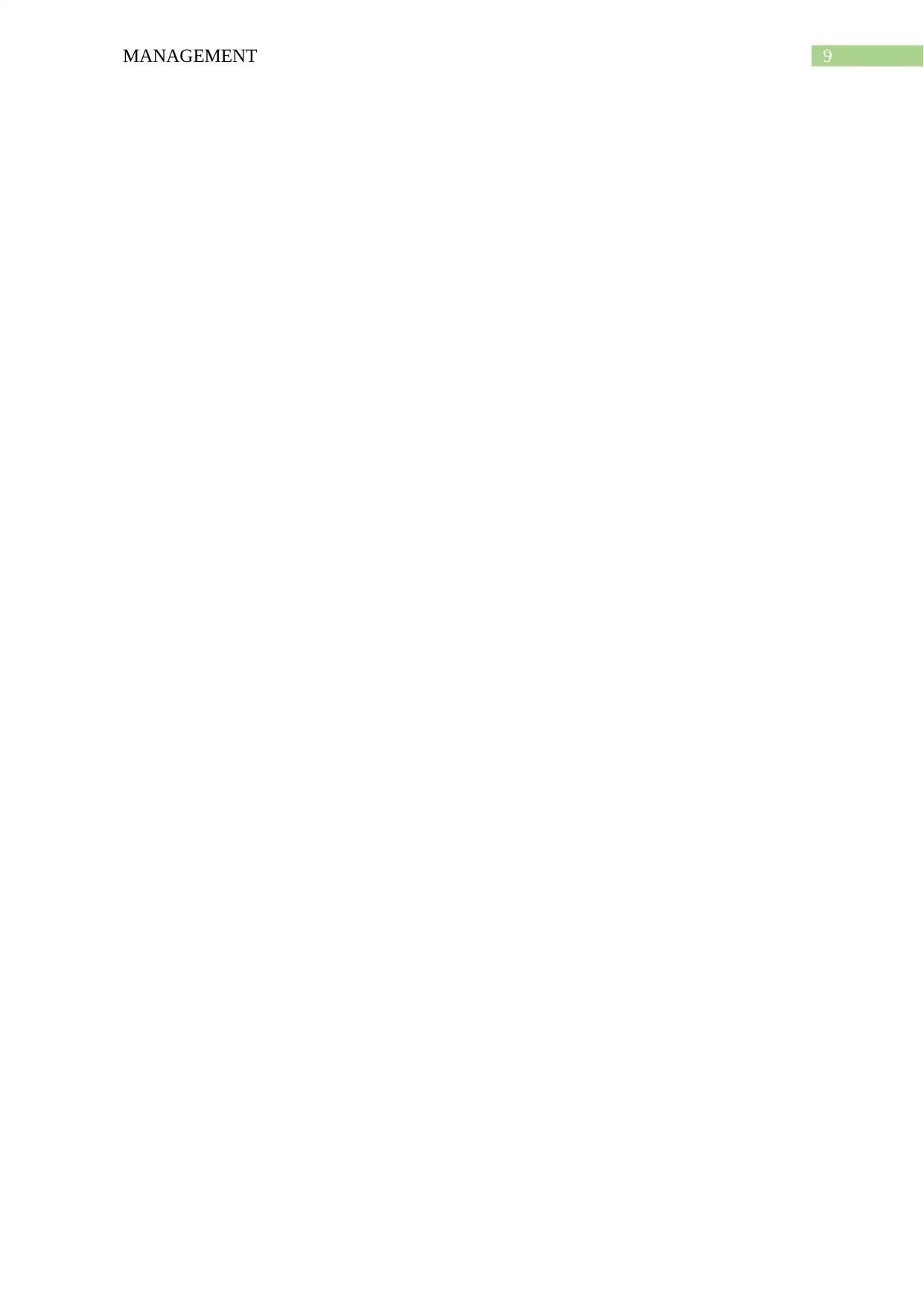
9MANAGEMENT
1 out of 10
Related Documents
Your All-in-One AI-Powered Toolkit for Academic Success.
+13062052269
info@desklib.com
Available 24*7 on WhatsApp / Email
![[object Object]](/_next/static/media/star-bottom.7253800d.svg)
Unlock your academic potential
© 2024 | Zucol Services PVT LTD | All rights reserved.





